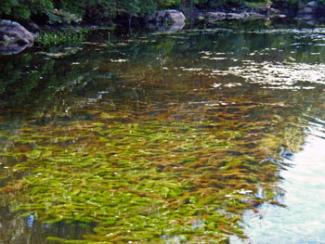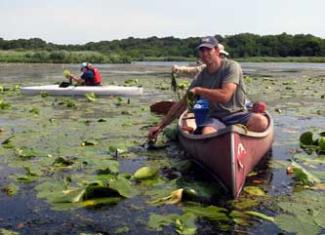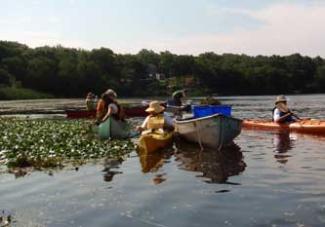Aquatic Invasive Plants

Native aquatic plants are an essential part of a freshwater ecosystem, providing many benefits to wildlife as well as humans. These benefits include:
- Provide habitat and refuge for aquatic animals
- Act as food sources for wildlife
- Recycle oxygen and carbon dioxide
- Reduce wave action, preventing shoreline erosion and improving water clarity
Aquatic invasive plants are non-native species that can disrupt the ecosystem and create nuisance conditions in freshwaters. Under the right conditions, aquatic invasive plants are able to thrive in our waters and can out-compete beneficial native plants that are naturally part of our aquatic ecosystems. Once invasive plants become well established, the density of plant growth not only degrades the native habitat, but often interferes with human enjoyment of water bodies by limiting recreational uses such as swimming, fishing and various boating activities. Left uncontrolled, certain species can "choke" a waterway, completely covering what was once open water with plant material.
The Problem with Plant Fragments
Most of Rhode Island's submergent invasive plants (found primarily under the surface) can reproduce, grow and spread through fragmentation. Fragmentation is a simple form of reproduction in which a plant is split into small fragments, and each fragment can then develop into a whole new plant. This means that even one small plant fragment caught on a boat motor, trailer or equipment can be transported to a different water body and start an entirely new infestation. This is one of the major ways invasive plants spread from lake to lake.
Which Aquatic Invasive Plants are in RI?
Aquatic invasive plants are widely distributed in Rhode Island freshwaters. See the factsheets below for individual species-specific distribution maps and lists or download the compiled document of all compiled species-specific distribution maps, allowing time for large file size due to maps and pictures.
Otherwise, you can see a summary of all invasives in the AIS distribution map and full list of infested lakes by town.
For more information about each species, click on link to the species factsheet in the table below, or click here for a packet of all invasive species factsheets.
To report new identifications of invasive plants, call RIDEM at 401-537-4217.
| Common Name/ Fact Sheet |
Species Name | Nearby Infestations |
|---|---|---|
| Didymo (rock snot) | Didymosphenia geminata | CT,NY, VT |
| European frogbit | Hydrocharis morsus-ranae | NY, VT |
You can take actions to prevent the further spread of AIS. It is essential for boaters and recreational users of lakes and ponds to be vigilant! Click here for tips on prevention.

AIS infestations are best managed by one or a combination of strategies. Management strategies must be tailored to the particular species of concern, the stage of invasion (see "How Aquatic Species Invade" for more information) and the physical characteristics of the water body.
CAUTION: Because some invasive plants reproduce by fragmentation, certain strategies, such mechanical harvesting, may not be appropriate and may contribute to the spread of the plants.
To view a chart of management options and their advantages and disadvantages click here.
Most management actions require the appropriate permits or approvals from DEM.
Hand-Pulling: By rule, the manual removal of submerged aquatic vegetation is restricted to that area adjacent to, but no more than fifteen feet from, existing or permitted docks, beaches or swimming areas under the Fresh Water Wetlands Regulations (Rule 6.02). Manual plant removal outside this area must be reviewed by the Water Quality and Wetlands Restoration Team.
Containment: Projects must be reviewed by the Water Quality and Wetlands Restoration Team.
Physical Controls (mechanical harvesters or hydro-raking) and Habitat Manipulation (water drawdown and dredging): Requires DEM wetlands permit. Contact the Water Quality and Wetlands Restoration Team for information.
Chemical Control (herbicides): Requires permit from DEM Division of Agriculture. Contact the RIDEM Division of Agriculture Pesticide Unit for information.
Biological Control: Projects must be reviewed and authorized by DEM Division of Fish & Wildlife.
Lake Management Plans
A comprehensive Lake Management Plan (LMP) is intended to identify critical threats that affect the beneficial uses (such as recreation and wildlife habitat) of the lake and to present strategies and recommendations to restore those uses. This plan can help address multiple lake issues, such as invasive plants, water quality problems and algae blooms.
A LMP designed specifically to target an invasive plant should be developed by a certified lake manager or licensed herbicide applicator who is knowledgeable about the species. To develop this type of comprehensive treatment strategy, a more detailed survey of the entire water body will likely be needed to assess the severity of the infestation and develop the most effective and cost-efficient long-term plan. Consulting a professional is appropriate to properly estimate associated treatment costs, outline the possible control options, comply with regulations, ensure environmental impacts are avoided and complete the project safely.
Water Chestnut Volunteer Management: Case Studies in Potential Eradication
Belleville Pond, North Kingstown

A small population of water chestnut in Bellville Pond was first discovered in 2007. A volunteer effort, organized by the Rhode Island Natural History Survey (RINHS), to hand-pull in 2008 resulted in good control of the population. Monitoring in subsequent years discovered only sporadic clusters of plants which were removed. RIDEM will continue to monitor the population and pull new growth when necessary. RIDEM anticipates follow-up monitoring and pulling will be necessary until 2020 to eliminate the seed bank.
Chapman Pond, Westerly

A large water chestnut population was discovered in Chapman Pond in 2009. An initial pull was held in October 2009 and resulted in the removal of approximately 1,600 pounds of plant material. A second volunteer pull in July 2010, before seeds had matured, removed 2,600 pounds of plant material. Both pulls were organized by the Westerly Land Trust with technical assistance from the Rhode Island Natural History Survey. Despite the amount of plant material pulled in 2009 and 2010, the large size of the population will require multiple future volunteer pulls for long term control and, eventually, eradication. Individuals interested in volunteering to pull water chestnut at Chapman Pond should check with the Rhode Island Natural History Survey for information.
